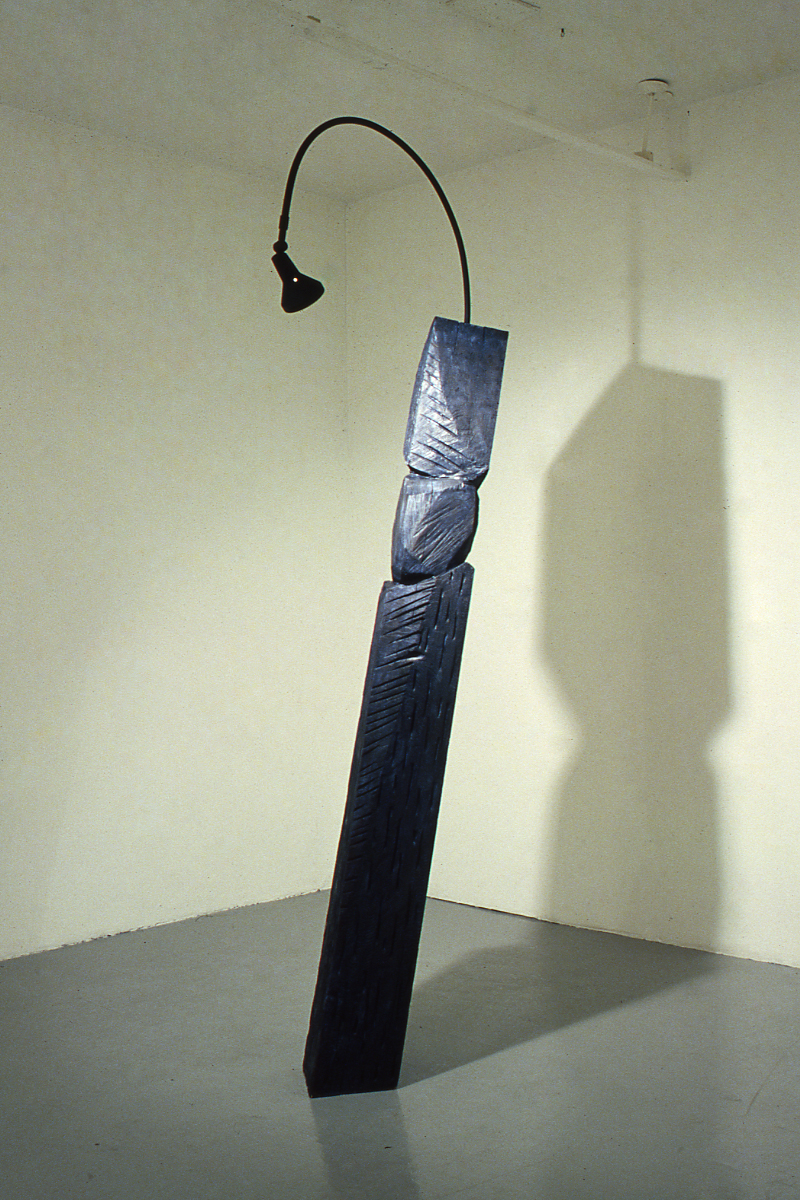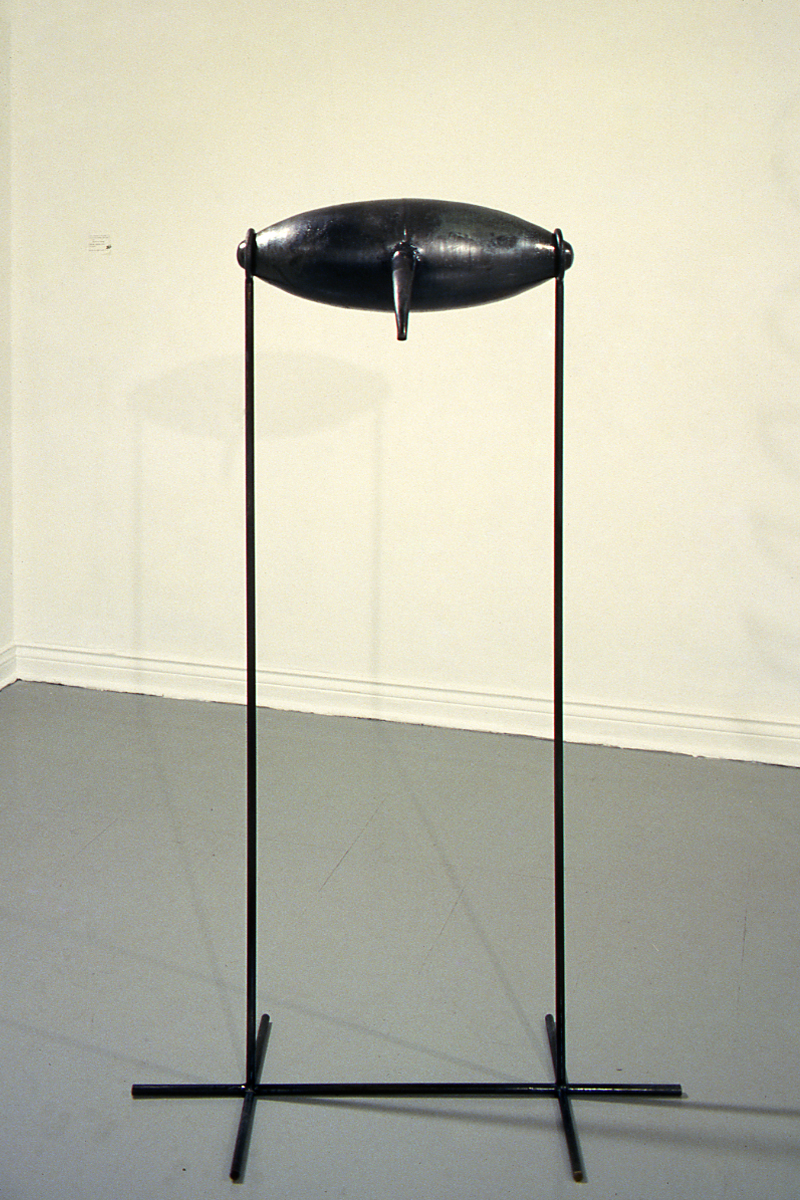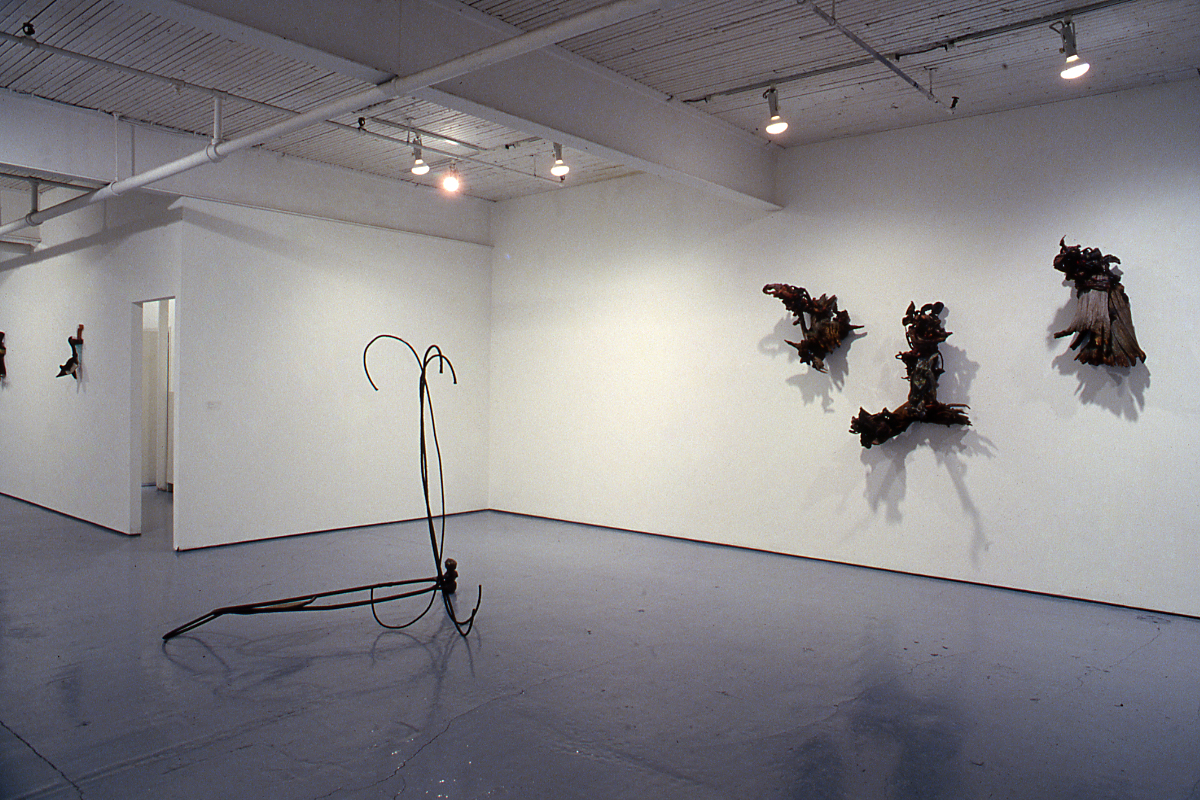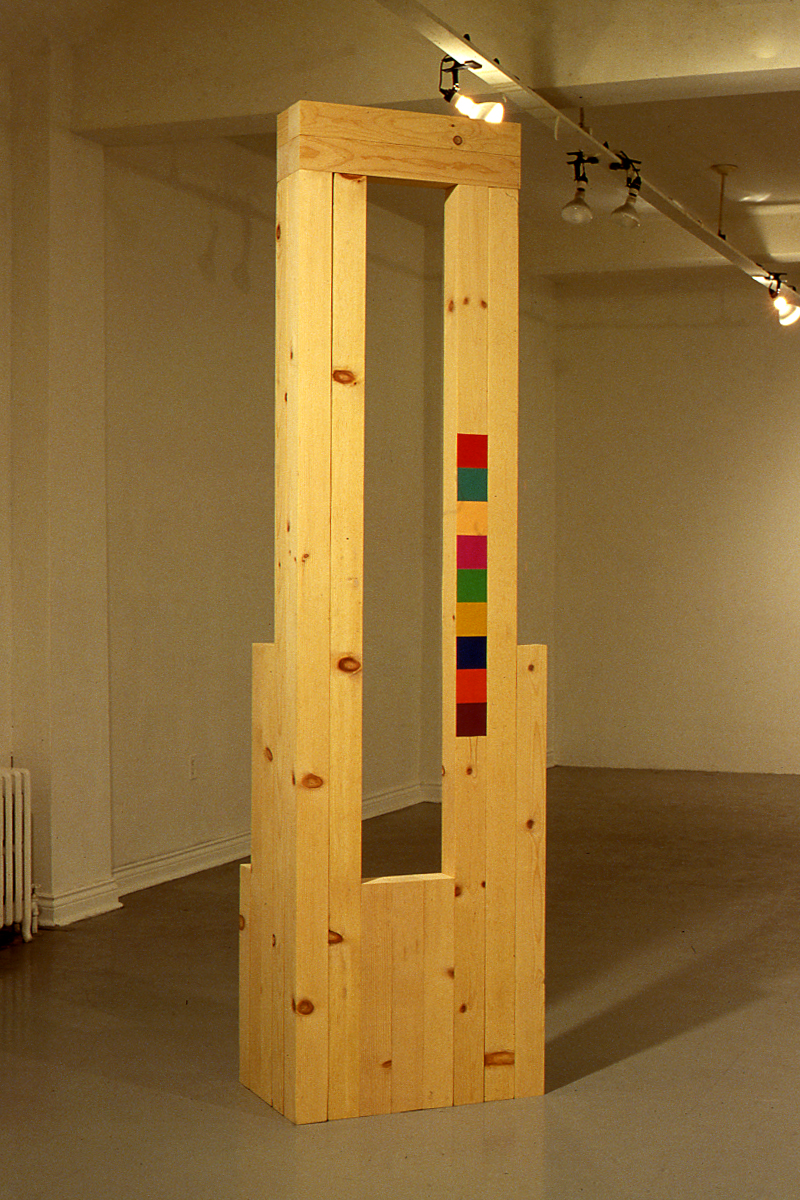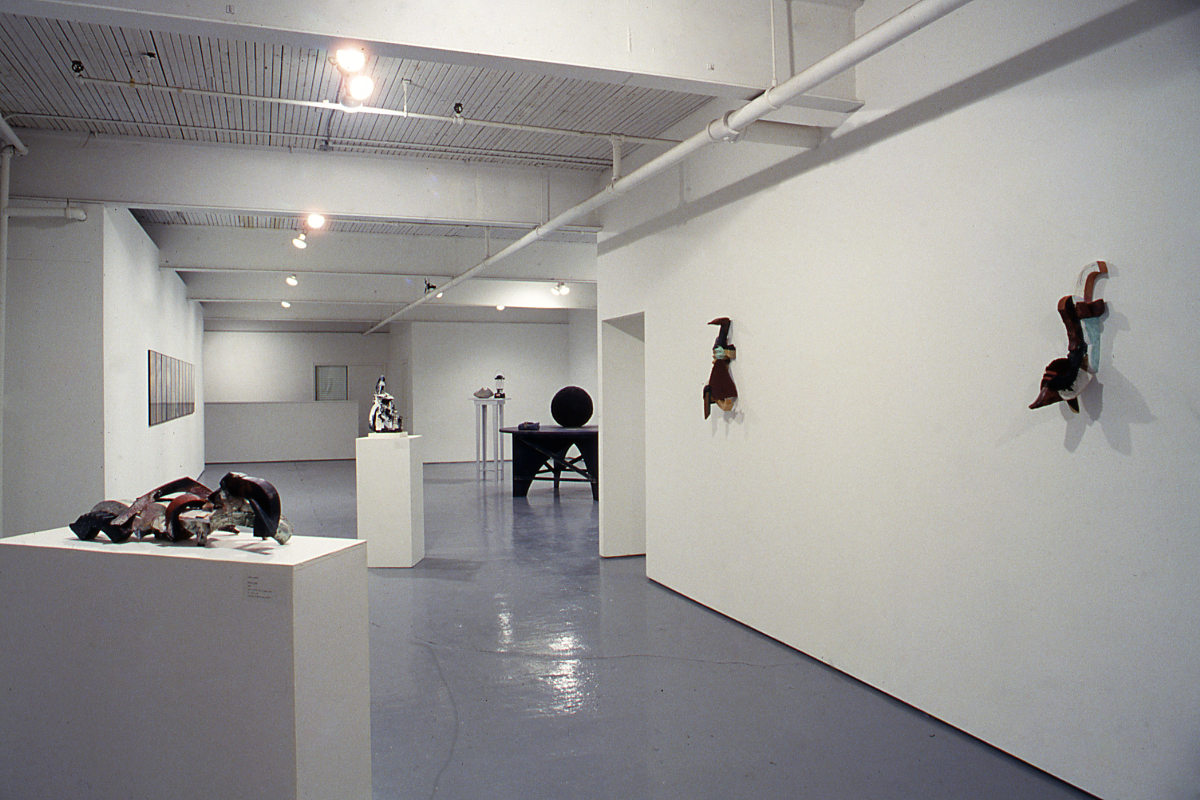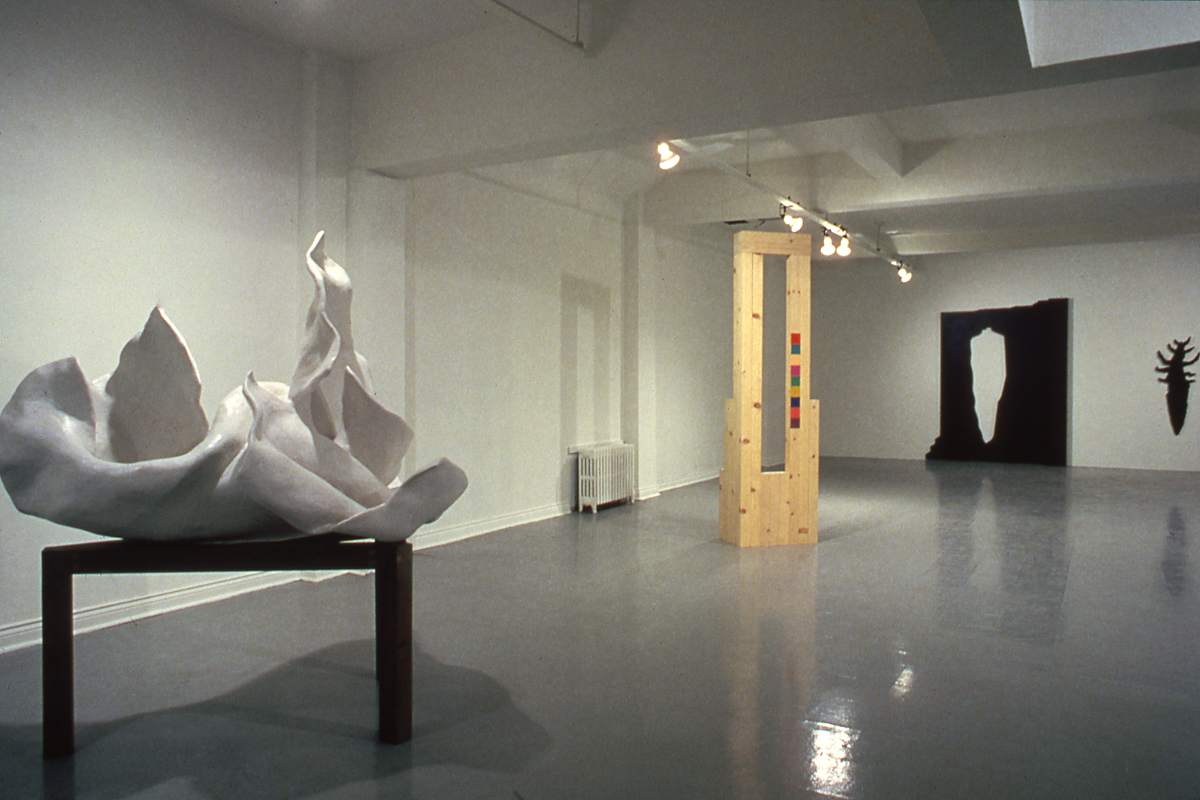East & West Galleries:
TEMPORAL ICONS, a two-gallery sculpture exhibition, will open at Mercer Union and A.R.C. on Tuesday, March 3, 1987. Co-ordinated by Shirley Yanover, Temporal Icons will address the concerns of contemporary abstraction in new work by Toronto sculptors Robert Bowers, Magdalen Celestino, Dyan Marie, Svitlana Muchin, John McKinnon, Reinhard Reitzenstein, Judith Schwarz, Irene Xanthos, Shirley Yanover and Calgary artist Carroll Moppett.
The exhibition will function as a survey of sculptors who have been working within this orientation, with all its diversity, bringing the work together in a large-scale thematic exhibition for the first time in Toronto.
"The sculpture exhibited will involve three dominant themes. The first premise of this work is that form and meaning are generated through abstraction. Each of these artists works with an intuitive logic that pushes at, that suggests, an implied meaning or layering of meanings. Either metaphorically, or directly, that 'meaning' can be understood as the projection of the living organism. It is in that sense that the work can be termed 'iconic'; each of these sculptors evokes a sculptural presence that is infused with an animated intensity.
Yet that very intensity is undercut, and the sculpture made uneasy, by means of the temporal. These objects do not connote permanence. These objects posit a 'whole,' yet this whole is at variance with the actual dynamic of the work. There is always the awareness that the sculpture is a thing of parts. Whether the construction is of disconnected units, or jointed, or bio-morphic, or whether paint is used as a skin or not at all, there is always the tension - intension of the impermanent.
The third focus for the exhibition has to do with scale. These sculptors, for the most part, are working with a 'body' scale, with proportions which correspond to the hand, head and to the body itself. Where figuration is not directly intended, it is implied through form. This scale evokes an assertion of wholeness, a sense of a 'whole' which is then, in varying degrees, put into question."
- Shirley Yanover
The exhibition catalogue, which will be available mid-March, 1987 and will provide documentation on the sculpture in Temporal Icons, artist statements and an essay by Toronto writer Jerry McGrath.
FOLLOW-UP PRESS RELEASE
TEMPORAL ICONS, a two-gallery sculpture exhibition, will open at Mercer Union and A.R.C. on Tuesday, March 3, 1987. Co-ordinated by Shirley Yanover, Temporal Icons will address the concerns of contemporary abstraction in new work by Toronto sculptors Robert Bowers, Magdalen Celestino, Dyan Marie, John Mckinnon, Svitlana Muchin, Reinhard Reitzenstein, Judith Schwarz, Irene Xanthos, Shirley Yanover, and Calgary artist Carroll Moppett. The exhibition catalogue will provide documentation of the sculpture to be exhibited, artists statements, and an essay by Toronto writer Jerry McGrath.
The following sculptors will be exhibiting at Mercer Union:
CATALOGUE TEXT: CORPORAL ICONS
published by Mercer Union & A.R.C., 1987
THINKING THROUGH THINGS
by JERRY McGRATH
The works assembled for this exhibition do not pretend to be exhaustive in their representation of a particular approach to the creative act. They do not claim the broad scope of a survey intent upon laying before us a particular mandate as it is taken up by artists working in Canada. (One of the most obvious facts of thisexhibition is that all of the artists, excepting one, live in Ontario and that all, excepting two, live within metropolitan Toronto.) Taken together, they ought to be considered a forum where certain approaches to the processes of making art are convened for the sake of establishing what may be common to them. It is not accidental that all of the artists are sculptors. Sculpture, as activity finding closure as object, is decidedly the focus. This focus has been further narrowed to exclude installation though this exclusion invites no judgement about, or challenge to, how such practice is worthwhile. It recognizes that installation art is primarily involved with context and environment rather than the object. Issues of context, while not banished from this domain,are de-emphasized. The works have not been assembled primarily to critique the manner and place of their appearance so much as to offer themselves as a kind of contained experience. As such, they are more than convenient occasions for comment on their situation within the gallery (system), marketplace and so forth. In otherwords, they are other than loci mapped out by brisk patterns too often given a too determinate reading.
In this sense, the exhibition acts somewhat as adjustment, inviting once again such notions as intuition, subjectivity and abstraction. Its interest in works linked in scale to body-size wishes to take note of the pressures on art to become a head-bound enterprise, something conducted at an indifferent or disdainful distance from a manual reckoning. Rather than seeing the artist as one who takes charge of meaning, it proposes one who accepts layers of meaning, not all of which can be recovered by verbalization. Accordingly, the artist given to implied meaning, who entertains a range of possibilities rather than prescribing only the specifically allowable, is called forth here. Such an artist does not pursue a model of efficiency whereby all is given over to communication: there is as well, a significant amount of fallout, spillage, a quotient of the indeterminate which is surrendered or freely given over into physical presence. This is not to suggest that the artists here are to be lumped together on the basis of a tactic of resistance building from disavowal of cybernetic models committed to communication. There are affirmative as well as negative tendencies at work here as well. Speaking on behalf of the object (a contradiction even more pronounced in view of the orientation of this exhibition but, nevertheless, a contradiction I accept), we can say that physical presence is more than material blockage of the transfer of information, more than slugs of stuff frustrating mechanisms of meaning.
In general terms, the sculptural object aims to go beyond the primacy of sight in its engagement of the sense(s). In that ambition, it breaks out into the world and, at the same time, multiplies the number of places it is disjunctive from that continuum. Its means of being are, in each case, singular -- as opposed, say, to the formal, rhetorical frame of a painting. There is an innate naturalism in the requirement of it being experienced in the round, of it engaging the viewer (here an insufficient designation) as an ambulatory agent storing and surrendering one impression in order to make way for others. This active, necessary involvement of the body in making sense of the work is a temporal tracing, although in greatly abbreviated form, of the pathways and detours of an artist's own involvement in the process of making.
Much recent art theory raises questions about the status of the art object within the context of a web known as late-capitalism. It characterizes its maddening resilience, the daunting elasticity typical of this construct and explains how it recovers, even from its margins, the efforts of those who would oppose it. Within this system it elaborates how radicality has become a seasonal thing, how it fills a space on the calendar, how it has come to be expected as market refreshment. The artist as producer is particularly susceptible to indictment in that s/he is seen to supply to the system artifacts which undergo privileged and conspicuous commodification. Furthermore, this theory places with artists the responsibility of exposing these structures of authority and jamming their mechanisms of repression. Interventionist strategies are proposed and, where they are found to occur, found laudable to the degree they threaten and disturb entrenched ideas and practices of a somnolent population and the conservative bureaucracies which administer it. In expanding their range of address, in going beyond the problems posed by the special areas of competence once kept apart by modernism, artists are expected to be exemplary. Aesthetics is considered to be a suspect scientizing of the politics of taste, a procedure which must give way to a reading of social, economic and political forces which position the artistic act. Such criticism wants no part in upholding faith in the transgressive (and, ultimately, transformative) function of art as a progress in (and through) plasticity. Far from that, it issues a call to resistance and deputizes an effort to take apart rather than make anew. It is suggested that artists dispense with professionalism for the sake of conscience and leave behind self critical allegiances to specific, high-cultural artifacts in order to work towards deconstructing problematical codes hitherto left intact in the broader culture.
In view of the foregoing profile, where must this present exhibition sit if not in the craw of so much near-millenial volubility ? It is not discursively involved with deconstructing popular media or appropriating its means in order to practice upon them a principled subversion. Far from that, it is premised upon process directed by intuition. In other words (those of de Kooning), "the art in it is the forever mute part you can talk about forever." Well, if that remark now seems like overstatement let it stand, let it for the moment serve as flag for this heterogenous regiment. (To highlight a situation hyperbole can be useful.) What is the source of this intuition? In purely physiological terms it is a right-brain function which, unlike verbalization, does not proceed as a serial, linear process but typically "takes into consideration a large mass of data in parallel, without separately considering each factor.1 Intuitional processes show the same hemispherical bias as does dreaming and have been so linked by experimentation on split brain function. In practical terms, in its bearing upon the production of works of art, it indicates an approach which accepts contingency; its reach towards resolution (or, at least, closure of some kind) is more aligned with connotative enlargement than with denotative fixity. In its material disposition, the intuitive is not a particular ministry targeting an explicit message. Since at its inception the intuitive understanding wishes to remain fluid, at its reception it must accept, beyond the object, umbrae and penumbrae which change according to the source of illumination. The viewer is invoked as sympathetic extension of the work; response is ideally a judicious juggling of impressions and associations which, in distillation, do not seek legislative or exclusionary form. A modus operandi such as sketched above does not go in the same direction as the tactically-inclined, 'semiotics smart' efforts of much recent art. Indeed, it does not overtly fret about its political correctness nor attempt to divest itself of subjectivity for the sake of saying how such a condition is pene trated by commodity culture. At this remove from what have been termed "the great narratives of modernity" it cannot, however, be arrogant about its condition of giving forth and is under pressure to recognize how it may be considered somewhat arriere. This should not be unduly troubling. In fact, it ought to be liberative. Relieved of modernist mythologies of the im moderate ego strenuously trying to stretch itself in order to be congruent with the art-historical moment, the intuitive process can reveal what is singular in selfhood.
In writing about sculpture here in Toronto, Donald Kuspit spoke of the value of work which exemplifies "a moment of disruptive idiosyncracy."2 It is this moment which he saw as responsive to an urgent need of resistant self: "In the postmodernist ideal of communicative ec stacy the neutralization, even excommunication, of affect -- finally becomes an ostracization of selfhood -- carries the modernist ideal of trans cendence to a reductive extreme."3 This is not a call for yet another extreme, a counter-measure whereby the exotic and the intractable postulate the oddball as a model of wholeness. It is a recognition of a grasp extending beyond style in search of something substantive, something more than a look. In that search, the maker of objects cannot issue the disclaimer that the material basis of his/her work is just stuff (as can the painter who may invent an extra dimension to dispose of this stuff).
The notion of intuition, because of its alogical resistance to language, is often wrongly held to be unaccountable, spurious to the degree that it carmot talk itself into position. Language often assumes an authoritarian function with regard to such excentric (apparent) intransigence. Michel Foucault, in an essay called We "Other Victorians,"4 explains how the modern discourse on sex (making it over into a construct called 'sexuality') reveals a controlling tendency in language. For all of its liberative ambition, language lends itself to pedagogical controls which banish as perverse a great number of pleasures and link sex to procreation. Moving for a moment from the natural plane to the cultural, from reproduction to production, we may suggest how language is there also inclined towards prescription. Just as the more fundamentalist elements from the moral domain do not countenance refusal of the biological imperative, just so the more 'radical' elements from the aesthetic/ theoretical domain insist upon refusal, reversing mirror-like the injunction to fertility with a demand for barrenness. I am thinking here of the high anxiety attending the perception of being collusively involved with furnishing, through one's labours, yet more stuff which, however confined and brief its circulation, must pass through the same gate as all else in the culture, that gate being the one marked by the dollar sign. In New York such anxiety is necessarily acute because of the prevailing bullishness which sees no legitimate drama in the middle ground and leaves one little choice between being pilloried or being set indulgently free. Toronto, on the other hand, or (if you can forgive this presumptuous enlargement) Canada, for that matter, does not match in pitch such laissez-faire antagonisms: for instance, a lot of the work in this exhibition will likely go back to the studios from whence it came. Here, marketing is not the same dizzy verb which there leaves George Washington looking so dog-eared and sounding so verbose.
Visitors at this exhibition may wonder what particular mandate may be attached to the fact that seven of the ten artists are women. I would resist a reading which might characterize this aspect as an affirmative, active swelling of the ranks on behalf of gender chauvinism. It would be too pat to ally the work of art (per se and as it is specifically found here) to gender-specific generative powers; we do not need such sentimental, vitalist models to go against the patriarch glaring from the other side of the coin. I am not suggesting the cancellation of noteworthy differences, especially those which give grounds for one gender's understandably extra investment in issues which line up behind an expansive definition of feminism. I am saying that, in my contacts with these artists, I detected no such manifest polemic.
Because restrictions of gallery space dictate that so many artists be represented by so few works, remarks bearing upon a broader picture may prove helpful in an expository way. Of course the reader will note in what follows something more (or less) than an account of matters of fact. Such remarks -- and indeed, this entire essay -- ought, I hope, to be taken as a kind of companion piece to the curatorial effort. Its aim is not to usurp this curatorial role but to follow it and, at times, to draw abreast of it.
Let us start then (on the geographical outside of this decemvirate) with Carroll Moppett an artist living in Calgary. Her sculptures--typically, small aggregates of tactile, often organic materials--seek a gestalt which also yields in the opposite direction, back towards a pleasure in the particular. Her work is busy with incident and surprise, diaristic in the sense of making palpable a temporal dimension which ultimately gathers these fragments into a governing perception. Such a perception may be allusively inclined towards either an architectonic or an organic model; whatever the case, Moppett's essential investment in the sensual, plastic quotient of a piece goes beyond transcription of idea or feeling to an emphatic thinking through things. Her formal vocabulary--in evidence here as elbows, wedges, crescents, ribbed convexities, spoon like concavities and stepped and serrated elements--come across as a refracted naturalism. It is her understanding that the natural world gives back something of the observer to the observer. In science such a position places objectivity in question; in art it establishes a link for subjectivity, rescuing it from pure interiority and giving it a ground into which it can impress itself as a conditional, relative freedom.
In her recent work Irene Xanthos makes a more direct citation of nature. She begins with fragments of American chestnut trees, a species which no longer flourishes. Excavation and retrieval are, at first, recognition of these elements as baroque disclosure of the forces which formed them. Expression as a gesture towards form is thus approached circumspectly, a citation from an endangered portion of the floral world. These blackened roots, stumps and limbs are subsequently bound together in assemblages with strips of darkly-pigmented fabric. This manner of checking and reversing is, in the artist's own words, an attempt at a "double organic" wherein her own efforts enlist an elaboration of natural processes and, respecting this disjuncture, continue from there. The wrapping and binding may suggest the (healing ?) arts in a less instrumental, more ritual function. As hybrids, they mark a nature/culture interface: the viewer is left free to reckon with this authorship, to determine how it is joined or remains split. These determinations are encouraged to take into account how psychological inflection and aesthetic requirement supervene upon the natural given and relocate it as something both taken and given.
Whereas Xanthos begins with actual evidence, solid residue of formative processes in nature, Svitlana Muchin begins at an earlier point in the cycle. In her last solo show she hinted at the gestational processes driving large, mutable units which, in an indirect way, often quoted portions of the body. For instance, emergent from one such unit might be a single oblique element like (in structure more than appearance) the thumb standing erect from a fist. By scoring lines upon a continuum of convex and concave surfaces she was able to invoke a discrimination between the inside and outside of some organic unit--without literally building the work as such. The difference rested on a double reading of the surface as skin and that which lies underneath though the incisions did not reveal any thing formerly unavailable to sight. In her most recent piece (for this exhibition) she has gone further in offering no cardinal physical orientation vis-a-vis the work; in look and structure it is membraneous and valvate, revealing a channel through a series of floppy-looking articulations which suggest fin, fishtail or the malleable convolutions distinguishing external portions of an ear. Invoked is the functional economy of the natural order, an economy which, all its great morphological variety notwithstanding, allows us to see correspondences and to sense in them adaptive, sympathetic form.
Nature, not as it is conventionally and familiarly visible, such as in its scenic aspect, but as it has come to be known through means supplementary to the eye seems to inform the work of Dyan Marie. I am thinking of her past 'Swamp' series and her recent 'Tropism' show in which are suggested respectively the capricious mutability of amoebic life-forms and, more soberly, the cross-sectional view. This latter, so emblematic of the spirit of research, marks this artist's adjustment in the direction of a more 'documentary' manner of bearing witness. Of course, the data is fabricated and only allusively linked to its sources, also of the artist's own manufacture. By these strategies Dyan Marie admits that the intuitive, subjective underpinning of her work (and the works of others so linked in approach) occupies a contested place. This would account for the inclusion in this exhibition of work which uses photography to give us details of previous pieces. As a tool, photography is only apparently free of the filter of temperament--a fact of which Marie is aware; she takes this tool to simulate a scientific spirit not in order to record bald fact but to reframe past pleasures.
For Judith Schwarz the object in its identity stands just shy of naming itself; when it appears to do so it nominates more than one reference. It exists in a relation of 'yes, no, maybe.' Some of her recent work, though rather biomorphic, carries a concrete skin, thereby using shape and surface to cancel simple oppositions and dislodge set associations about technologies and tactility. Her orientation to the body and its scale--going back to her experience as a dancer--has generated works in which parts of the body figure as impressions in otherwise monolithic concrete blocks. Sometimes these impressions declare the body part(s) while, at other times, they persist as a kind of abstract, eroded morphology. Even more recently she has moved away from the massive to reticulated and fluted surfaces which insinuate, envelope and contain, thus evening the balance between space and substance in her work. This move has also accommodated a kind of Arp-like language of elementary forms cut from (or into) steel plate. This language appears to be linked to perceptual strategies of early abstraction insofar as it aims to set specific limits on its generality and yet wishes to remain ambiguous in its specificity.
This aspect of naming is more forthright in the work of Magdalen Celestino. In fact, it would be hard to consider her work as subscribing to an ideal of abstraction. Over the past few years she has created a vocabulary of small objects which are given, by proximity and isolation (on the floor, on shelves and on tables), a broader 'syntactical' relation. These objects include commercial and unique casts of hands, spoons, tree branches, ladders, huts, nest-like enclosures, bud-like forms, spheres, cones, and irregular brick-sized units which suggest the detritus of shattered larger structures. This plural, combinative approach gathers such elements together in provisional, poetic constructs wherein the gaps (or, continuing the metaphor, caesurae) are also made evident as extension or support (again, floor, shelf and table). Constellation and alignment of elements, though settled, determined to a point, may not be assured or authoritative. Implied is a kind of associatory licence which tempts the viewer to supply the 'glue' to cement together these little republics of objects. Since the abstraction is not to be found in the objects themselves perhaps it can be located in Celestino's withdrawal of anything finally consensual between them.
In the case of Robert Bowers we find an artist who shifts between showing work which indicates links with now-classically-received artists (like Brancusi, for instance) and work which, on the face of it, is even closer in its hints of folk derivation. His objects include whimsical, 'ceremonial' benches and verticaly-composed carvings of both an urbane and apparently-tribal provenance. In both physical and metaphorical terms, the vocabulary is demonstratively activated; his efforts are involved with finding a place for a strenuously manual expression (without finally going so far as to fetishize it as a single, qualifying ethic). It is an empirical approach positioned within an idiom which acknowledges influences, though not for the sake of serving, in his own words, "the imperatives of history." This positioning is personal and not irresponsibly individuated. While given to the broad, bold gesture he is also attentive to (and accepting of) secondary effects such as facture, olfaction, pigmentation and the accidental extras that are part of his materials.
Reinhard Reitzenstein is another of these artists whose schemata have, at times, a referential yield. He can be figurative though not always conspicuously so. The apparently reductive look of his work does not aim to excise our pre-industrial heritage and welcomes readings which go beyond a blunt equivalence between material finish and temporal positioning. A passionate interest in anthropology informs his work: his investigations are sometimes carried on first-hand. His structures, while sometimes acting as cautions, are also meant as antennae which pick up signals from cultural patterns other than our own. In their vertical disposition, Reitzenstein's pieces can have an hieratic quality which gives the impression of conducting and focusing energies that have less to do with physical events than with collective cultural moments. His vocabulary is an outgrowth of an allusive approach that is, though leaning towards abstraction, not governed by any entrenched dicta.
Like Reitzenstein, John McKinnon tends to the leanness of a sketch rather than piling up mass. He too works in metals, having chosen a resistant medium in order to minimize the risk of falling into facile manipulation of materials. His pieces are narratively-inclined configurations of elements which take on what he has described as a "structural/skeletal" character. With his clue-like titles he often establishes our contact with his work as arrival at a signal moment in story, allowing that such a moment may be event and/ or affective state. Into this work he inserts biography, spiritual thematics and (thinking of one work in particular) episodes 'illustrating' marvels of adaptive function in living organisms. His method is a kind of cryptographic notation moving back and forth between ontogenic, phylogenic and cosmogenic dimensions, all of which are drafted into a single levelling scale.
Shirley Yanover works from large rectilinear and curvilinear elements of wood wrought to more architectonic ends (though also, some times, like Reitzenstein, of a figurative import). In aspect they often appear unstable and digressive--and deliberately so in order to avoid arrogating to themselves, even in more vernacular terms, a classical repose. Readymade elements such as alphabet blocks, miniature statuary and links of chain deliberately confound her own manufacture, inserting into her construction eclectic asides and suddenly-fluent identities which seem to rush the circuitous pathways of her own creation. In a sense then, her work is a staging of these different signatures, both temporal and authorial, a giving of edge to hesitancy so that it does not appear indolent or lacking in resolve but, on the contrary, projects a measured advance. This is not a back door approach to the aforementioned repose; far from it, her works are energetic but, rather than pushing a simple efficiency and optimism, admit of a certain entropic expense.
